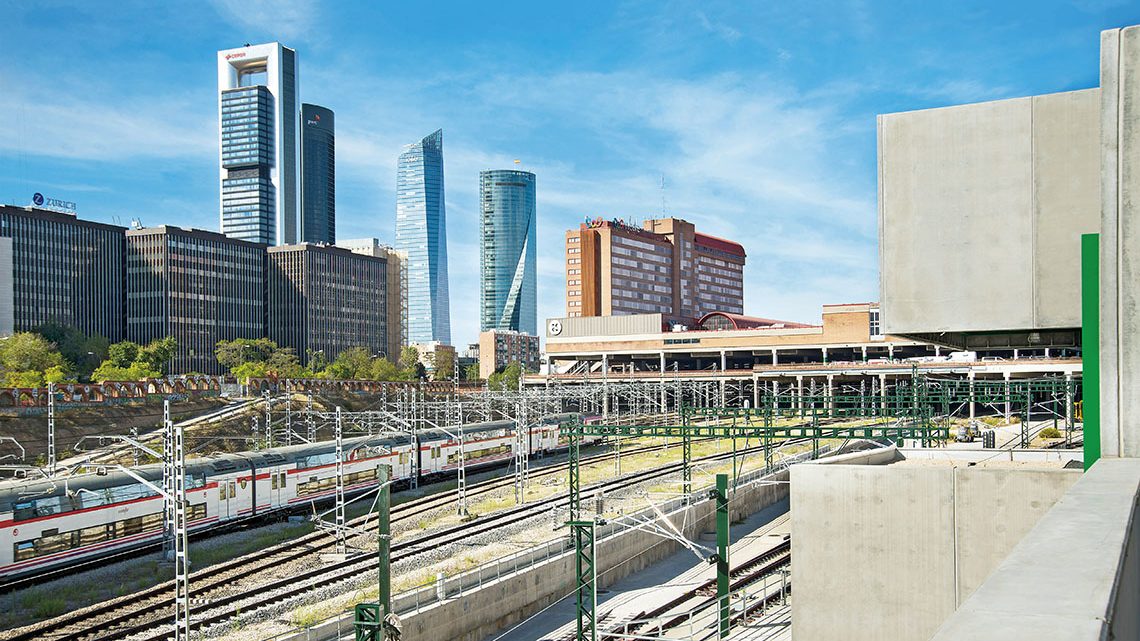This project, approved by the Ministry of Public Works in March 2015, is very important for Spain’s rail network. When completed, the high-speed lines of the north, south and south east of the Iberian Peninsula will be connected by a 6.8 kilometre-long tunnel (7.7 kilometres including the tunnel bypass). The use of the international track gauge on the line will shorten travel times by 30 minutes by precluding the need for trains to pass through gauge changers. When the future Atocha through-station is built, Madrid’s two high-speed stations will be connected.
The quadrupling of the track will increase the capacity of the railway infrastructure between Puerta de Atocha station and Torrejón de Velasco, where trains are diverted to the east or south of the Iberian Peninsula. The commissioning of these two new sections, in addition to the two existing ones, will alleviate the congestion on the saturated access lines to Atocha and speed up and facilitate greater density of rail traffic, thereby benefiting the Levante and Andalusia high-speed corridors, as well as removing the need for the existing north-south routes (such as A Coruña-Alicante, Alicante-Gijón, Alicante-Santander, etc.) to pass through several gauge changers.
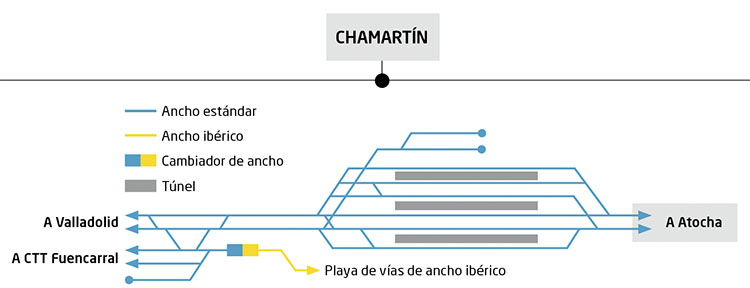
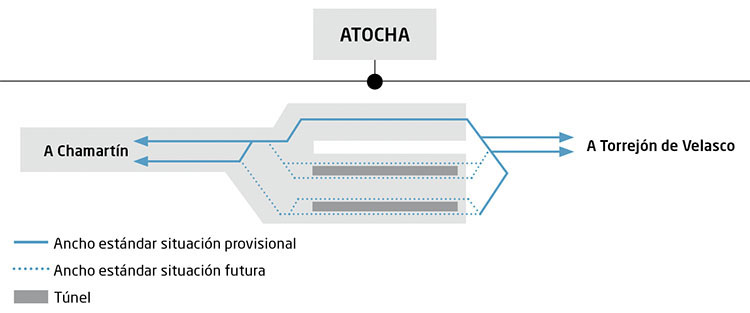
Track diagram of the new HSL Centre between Atocha and Chamartín (temporary and future arrangement).
OUTFITTING THE HS LINE
The work that the company Adif Alta Velocidad is currently completing includes track assembly, electrification and installation of safety and communications equipment, activities on which Ineco is collaborating by providing consulting services and technical assistance work for monitoring and supervision.
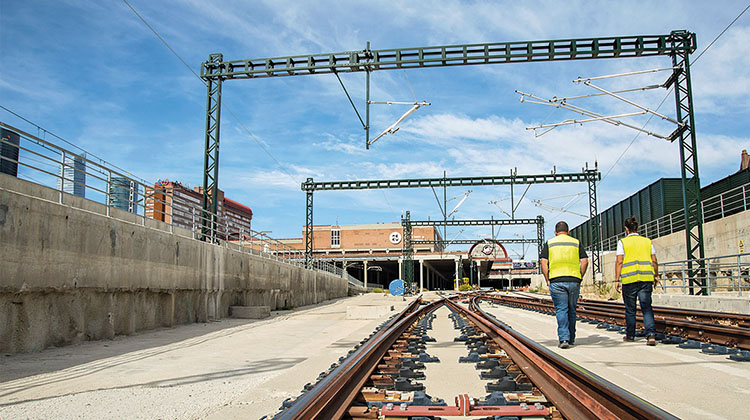
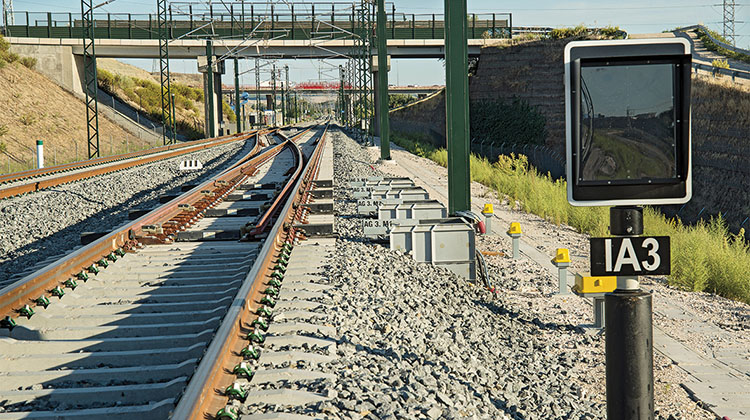
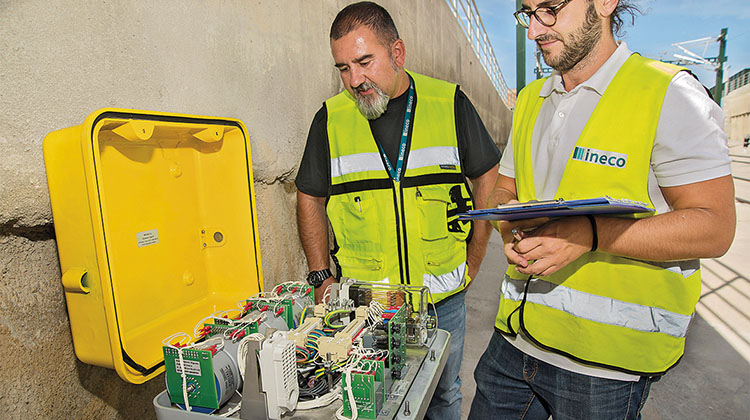
In terms of track assembly, the stretch is divided into two sub-sections: Chamartín-Atocha (8.21 kilometres), which consists entirely of slab track except for a small section on ballast in the transition area from double track to single track at the fork leading to the future through-station and provisional tunnel, and Atocha-Torrejón de Velasco (27.65 kilometres), where the track has been installed on ballast. The project also includes work on Chamartín station, where a railway yard with the UIC international gauge has been built at its southern end.
Regarding the connection of the Southern and Levante high-speed lines at Torrejón de Velasco, two parking tracks, each about 200 metres long, had to be adapted to high-speed line parameters.
THE DEEP TUNNEL THAT PASSES UNDER THE CAPITAL
The tunnel between the Madrid-Puerta de Atocha and Madrid-Chamartín stations is an essential infrastructure for the development of an international-gauge network in Spain, as it allows the interconnection of the high-speed lines that pass through Madrid, facilitating the interoperability of high-speed trains.
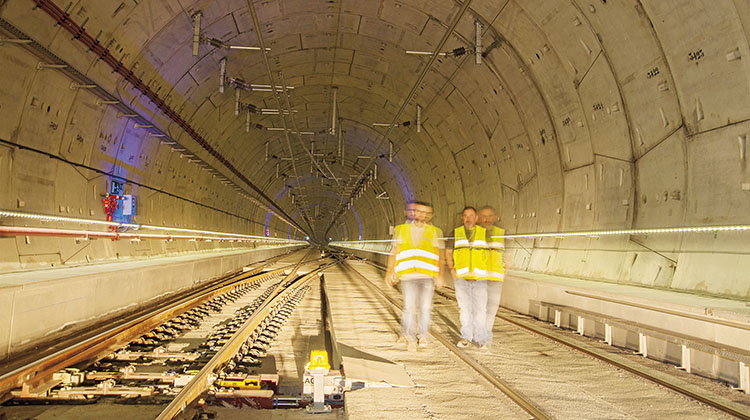
Atocha-Chamartín tunnel (Madrid). / PHOTO_ELVIRA VILA
According to Adif, the tunnel, whose boring was completed on 11 February 2011, improves the operating model of the two Madrid stations converting them from a terminal configuration to through-stations. Commissioning of the tunnel will also facilitate high-speed train access to the Fuencarral railway workshops (in Chamartín) and Cerro Negro workshops (next to Atocha) for maintenance. Once the Atocha through-station is built, Madrid will have the luxury of having its high-speed stations connected, a situation that is still pending in other major European cities. Operators will be able to choose between Chamartín or Atocha stations for their high-speed train arrivals and departures to and from the capital.
With a length of 6.8 kilometres, the tunnel, whose boring began in 2010, runs under the city’s main arteries and emblematic monuments and buildings such as the Puerta de Alcalá and the Archaeological Museum. Equipped with some of the most modern railway technology available in terms of safety and protection systems, it boasts a slab track with embedded rail, rigid overhead catenary, nine emergency exits and signalling and communication systems with a high level of safety. From the very start, Ineco participated by providing Adif with project and environmental management, geotechnical consulting, building inspection and acoustic monitoring services. Ineco was later responsible for technical assistance on track assembly, electrification and signalling.
Nine emergency exits
Constructed at a depth of about 40 metres, the tunnel features nine emergency exits, one per kilometre: three along Serrano and the others at Atocha, Calle Espalter, Plaza de la República Argentina and Calle Hiedra, Calle Alberto Alcocer and Calle Concha Espina. In the image, the emergency exit leading to Calle Espalter.
A UNIQUE TECHNICAL BUILDING
The building has fibre-reinforced concrete panels and a tubular steel substructure, instead of the usual concrete walls, making it possible to optimize the installation of the façade insulation.
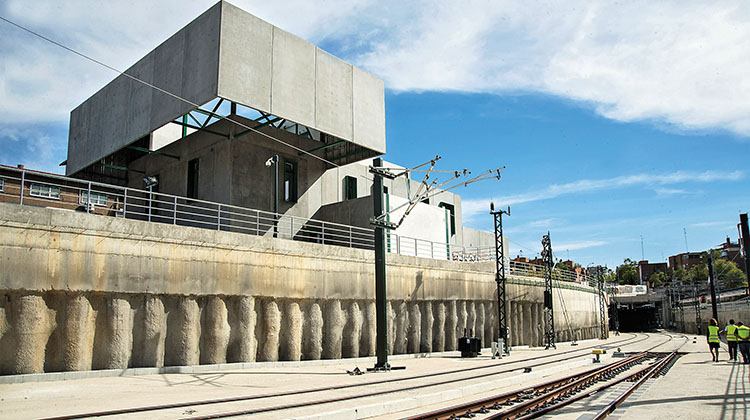
Chamartín technical building. / PHOTO_ELVIRA VILA
The technical building at Chamartín station on the Madrid-Chamartín-Torrejón de Velasco section has two floors to house equipment for services (power, batteries, telecommunications and signalling) as well as offices, storage areas, access roads and a platform for loading and unloading. The Siemens-Thales Joint Venture constructed the building from a project drafted by Ineco, which also provided site management with technical assistance.
In spite of the industrial nature of this type of technical building, an appearance that fit better with the urban environment was sought and achieved thanks to the choice of prefabricated GRC concrete panels (fibre-reinforced concrete), which required minimal thickness, with stiffness provided by the tubular steel substructure. The space gained was used to install the insulation, which is continuous across the façade, minimising the number of thermal bridges. This prefabricated panel system makes it possible to have many different tones, textures and designs. These details make these walls different from typical concrete infrastructure walls and make them resemble prefabricated architectural finishes used in urban construction.
WATCH THE CALCULATIONS
The commissioning of the section of high-speed line between Madrid-Puerta de Atocha station and Torrejón de Velasco, slated for 2018, required the inspection of 34 new structures with a total length of 3.1 kilometres, a job carried out by Ineco for Adif.
Last summer, Ineco began carrying out load tests and inspections on all of the structures of the section between Atocha and Torrejón de Velasco of the new Levante rail access, which passes through the southern part of Madrid and the towns of Villaverde, Getafe, Pinto and Torrejón de Velasco. In total, the new tracks have 34 structures and more than 2.5 kilometres of viaducts. The work to be carried out on bridges, pergolas and viaducts in this type of contract includes full verification of the condition of the structures, consisting of formulating inventories, preliminary inspections, bridge instrumentation, carrying out load tests, as well as calculating the bridge behaviour during testing, and ending with the main inspection of each structure and completion of A1 (communication of inspections to the register of railway bridge inspections) and A2 (load test report) procedures. All of this is collected and published in the final load-test report. This ensures compliance with the mandatory Instruction on Railway Bridge Technical Inspections (ITPF-05), which regulates both inspections and load tests carried out on newly constructed bridges, as is the case, and even on service bridges.
Its most significant infrastructure –in addition to the Chamartín-Atocha tunnel mentioned above– include the provisional tunnel under Atocha station, 879 metres long and consisting of single track, the Perales cut-and-cover tunnel (390 m), and the viaducts over Calle Comercio and the C-5 commuter rail line (127 m), the Abroñigal viaduct (149 m), the Santa Catalina viaduct (429 m over the M-40, and a total of 649 m), the 1.1 viaduct over the Madrid-Levante HSL, Seville branch (1,079 m) and the pergola over the Madrid-Seville HSL (93 m).
THREE UNIQUE METAL VIADUCTS
Of the 34 new structures, three unique viaducts stand out for their location, design and construction process:
- Comercio street viaduct
This is a 129.5 metre-long bridge with steel structure and auxiliary elements weighing 1,130,000 kg over Calle Comercio and the C-5 commuter rail line (Móstoles-Humanes). Its highly complex construction is due to the viaduct structure with a variable radius of curvature. The structure consists of two metal lateral lattices on both sides of the railway platform, connected every 3.50 m by metal beams on which the concrete deck rests. It has a total length of 129.5 m, distributed over 4 continuous spans. The viaduct construction was executed in such a way as to minimize the disruption of public roads and rail traffic.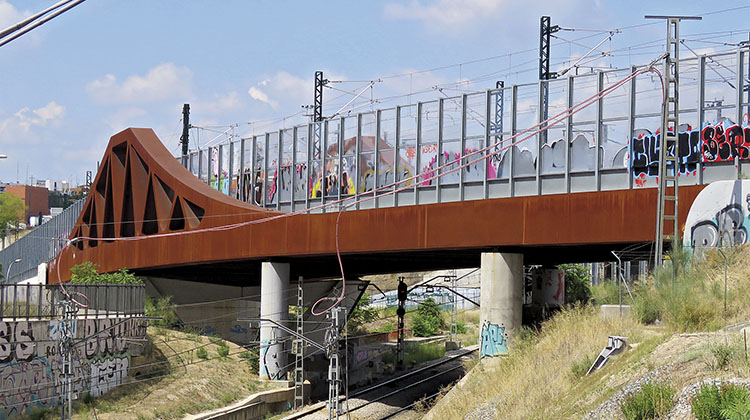
Comercio street viaduct (Madrid).
- Abroñigal viaduct
The Abroñigal viaduct is located near Atocha station, next to the C-4 commuter rail line. It covers a length of 144.5 metres and is built with three spans on a large metal structure with reinforced box-girder elements and welded joints, forming a thick sail-shaped lattice, with a reinforced concrete deck on floor slabs, joined to metal girders by metal connectors. The track layout is straight but eccentric towards the left-hand side. The bridge can only be accessed through abutment 1 (Atocha side), fitted between the tracks on the left-hand side and the embankment towards Calle Embajadores. The access tracks to Adif’s Entrevías workshop and the road tunnel from Calle Embajadores to the same workshop run beneath it. This was a conditioning factor for both the construction as well as the load test and the inspection.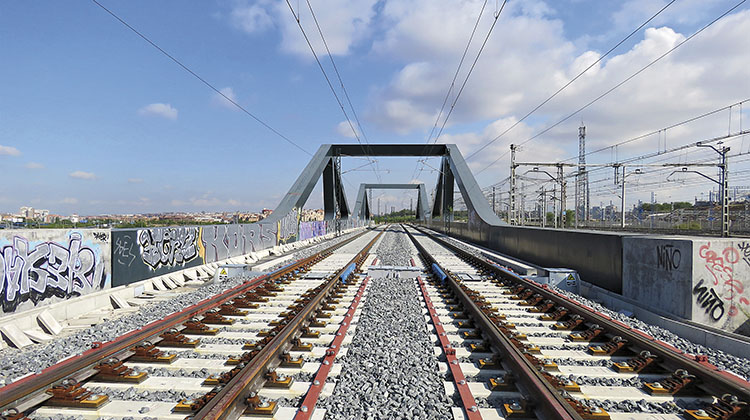
Abroñigal viaduct (Madrid).
- Torrejón de Velasco: viaduct over the Madrid-Levante HSL
The section between Torrejón de Velasco and the branch that connects to the Madrid-Andalusia high-speed line runs between the municipalities of Torrejón de Velasco (Madrid) and Yeles (Toledo), and corresponds to the branch that connects the Madrid-Castilla La Mancha-Valencian Community-Region of Murcia and Madrid-Andalusia high-speed lines. The railway track is over 7 kilometres long. This section’s most notable elements include the construction of a 1,079 metre viaduct and a pergola 93 metres long. In the case of the load test, in order to avoid interfering with the lower track, the vertical sag or deformations of the metal deck of span 10 was measured using a laser. In terms of the inspection, it posed the usual difficulties of a viaduct of this size, such as inaccessible metal elements, except for the deck, which has hatches in the bottom sheet in sections 9 and 11, next to the part that joins to the concrete deck.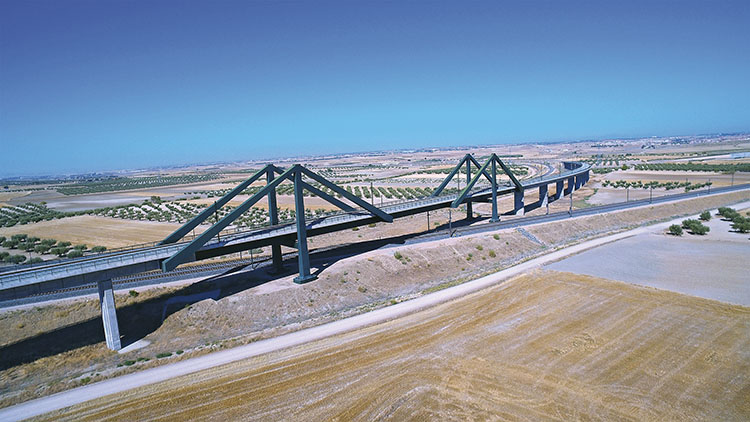
Madrid-Levante HS viaduct (Torrejón de Velasco).
Installations on the Chamartín – Atocha – Torrejón de Velasco section
SIGNALLING- Enlargement of the electronic interlocking system in Madrid-Chamartín high-speed train station, new electronic interlocking system at the Botanical Garden and modification of the system in Torrejón de Velasco.
- Equipment installed in the field: audio frequency track circuits, electrohydraulic point machines, wayside LED signals, etc.
TRAIN PROTECTION SYSTEMS (ERTMS AND ASFA)- ERTMS L1 train protection system and enlargement of ERTMS Levels 1 and 2, at the southern end of Chamartín HS station and ASFA system as a second operating level.
- New ERTMS control centre, PCE.
- Fixed and switchable ASFA and ERTMS balises, implementation of transitions between the corresponding levels in each case (L2, L1, LZB) at the ends of the line.
FIXED TELECOMMUNICATIONS AND PROTECTION AND SAFETY SYSTEMS- Fully-redundant fibre optic network on both sides of track and fibre optic supervision system.
- Automatic telephone system.
- Interconnection of the section’s networks with the CORE MPLS networks and the Madrid-Valladolid and Madrid-Levante sections.
- Video surveillance, access control and anti-intrusion system.
- Integration of civil protection systems.
AUXILIARY DETECTION SYSTEMS- 21 falling object detectors.
- 1 hot box detector.
- Auxiliary detecion system telecontrol for the integration and display of section detectors.
CENTRALISED TRAFFIC CONTROL (CTC)- Enlargement of Madrid-Valladolid and Madrid-Seville CTCs and adaptation of Madrid-Levante CTC.
POWER SUPPLY- Power supply to the field equipment through a 750 V line from the line suppliers (technical buildings and signalling buildings).
- Electrical connections for Chamartín-Atocha tunnel, technical buildings and electrical substations in Villaverde and El Hornillo.
BUILDINGS- New technical building at the southern end of Chamartín.
- Technical sites at Canal del Manzanares and Cerro de los Ángeles.
PROTECTION AND SAFETY SYSTEMS


